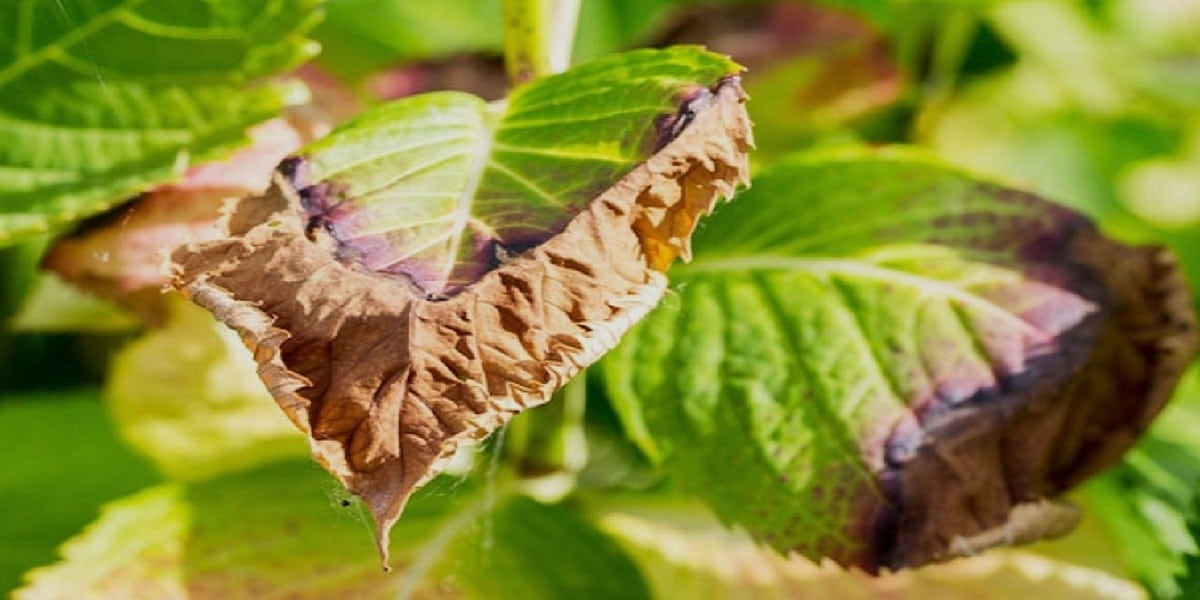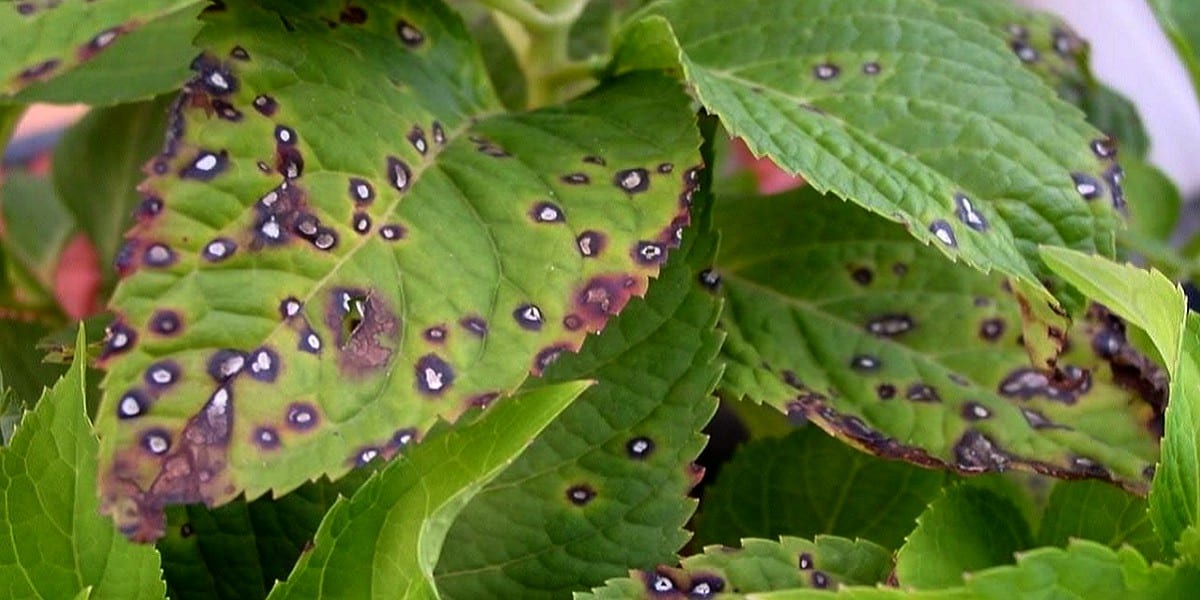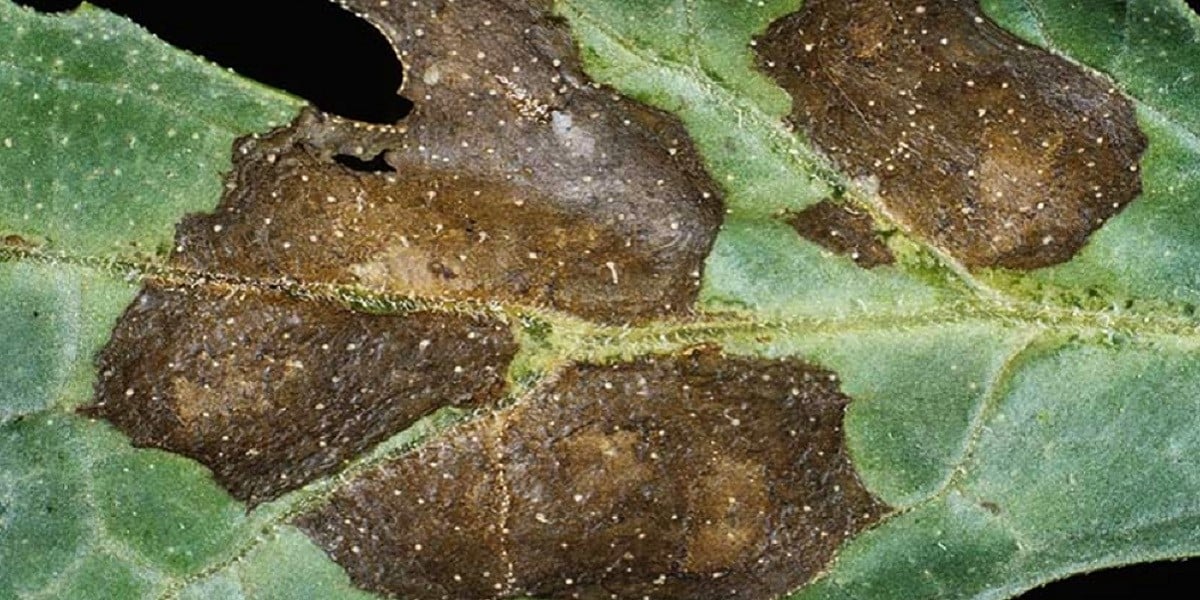Many gardeners adore hydrangeas for their magnificent spherical flowers. It is one of the most beautiful flowering shrubs, striking with the elegance of its forms, the brightness of colours, and the shades of its huge inflorescence caps, which change colour several times throughout the summer. It can become a real gem of your garden, but it can also be grown indoors.
It might seem these magnificent bushes really require a lot of attention. It is not true; hydrangea is considered not the most demanding plant. However, you need to follow some nuances for the flower to please you with its appearance and not get diseased. Some critical mistakes can lead to brown spots on hydrangea leaves. We’ll tell in detail why it can happen, how to determine the exact cause, and how to cure your favourite bush.
Brown Spots on Hydrangea Leaves: Overview and Definition
Hydrangeas can have flowers of different shades, while the hue can be adjusted with the help of fertilizers and changing the soil acidity. Leaves, as a rule, have a uniform light green or green tint, less often with white stripes along edges. Any changes in the colour of the leaves or the appearance of strange spots catch the eye pretty quickly. Although this shrub is considered not very demanding, it is quite sensitive to water quality, lighting, and ground acidity. If the recommended care methods are violated, hydrangea diseases may appear.

The brown spots on hydrangea leaves can have several reasons at once, which are somehow related to each other. No matter what type of these plants you grow, they might have common problems:
1. Metabolic disorder
It can appear due to non-compliance with the recommended watering conditions and plant maintenance. A hydrangea does not like the scorching sun, lack of moisture, and sudden changes in the state of the soil. Also, this bush is intolerant to frost, especially in spring. However, the worst thing for this plant is excessive watering and, as a result, compacted ground. All these factors slow down and even completely stop the metabolism. It leads to brown spots on hydrangea leaves, slower growth of the bush, and the withering of foliage.
Too hard water with a high lime content also manifests itself in the form of darkening of the leaves. The fact is that this bush is quite sensitive to lime. It is best to water it with rainwater. However, if it is impossible, you should collect tap water in containers and let it stand for a while. In some cases, even this can’t save you from the fact that hydrangea leaves begin to change colour.
Dark spots can also appear due to sunburn. If you carelessly water the bush and drops of moisture fall on the leaves, the sun is refracted, leaving burns. Although this problem can be eliminated only by more careful watering, damaged leaves will disappear after they fall off. Fortunately, it does not have a detrimental effect on the plant as a whole.
Often the cause of the appearance of brown spots on hydrangea leaves is the lack of proper nutrition in the soil. If you grow your shrub outdoors in one area for a long time (more than eight years), the ground is depleted and requires the application of fertilizers explicitly designed for flowering plants.
2. Fungal diseases
Improper watering, excessive moisture, poor drainage, and cool weather promote mold and mildew development. All these factors can lead to the appearance of root rot, as well as dangerous fungal diseases that spread quickly in the ground and can easily infect nearby bushes. Their particular danger lies in the fact that spores and bacteria can persist in the soil and pieces of dead plants for quite a long time. They become more active as soon as a favourable period for them (and unfavourable for flowers) comes.
Fungal diseases have a fairly extensive classification, but gardeners often face several basic problems. Fungi such as Septoria can cause plant diseases that appear as large yellow-brown spots with black dots in the centres. It starts with old leaves and gradually spreads to the entire bush. In neglected states, this fungus can destroy up to 30% of the plants on your site. Gray mold appears as a grey, soft-touch coating. At-risk young flowers and shoots are not yet strong enough to withstand the effects of overwatering. It can be transferred from leaf to leaf by direct contact. Damaged areas eventually die off completely, turning into dust. Downy mildew has a similar effect; only the spots take on a “greasy” surface. Also, Mycosphaerella brassicicola is often seen on hydrangeas. The higher the humidity level and the longer it persists, the more brown spots on hydrangea leaves.
3. Pests
A weakened plant growing in the wrong conditions is an ideal insect breeding ground. Among the most common pests are aphids, root-knot nematodes, bedbugs, spider mites, owlet moths, leafworms, snails, earwigs, and others. They like to eat young shoots and flowers; bite sites turn yellow and darken over time. With extensive damage, parasites suck out a significant part of the plant’s juices, which will cause it to die. It should be noted that a healthy hydrangea is quite resistant to most parasites. So you just need to adhere to the recommended conditions to arrange competent pest control.
Dark Spots on Hydrangea Leaves: Symptoms and Diagnosis
The reasons described above can cause great harm not only to one infected bush but to all plants that grow or stand nearby. That is why to interrupt the disease cycle; you need to take care of the flowers and take action on time. However, first, you need to understand what exactly you are dealing with.
Suppose brown spots on hydrangea leaves appeared due to improper watering or excessive moisture, but you noticed the disturbing condition of the bush on time (that is, the problem did not develop into a severe disease). In that case, you may not notice other changes apart from dark spots. If the flower is in a humid environment for a long time, you will see that the leaves begin to wither and just hang on the branches. The growth of the plant and the appearance of young shoots slow down. Ball-shaped flowers become smaller in size, and sometimes shrubs may not bloom at all.

More severe conditions develop into root rot. In this case, slippery and brittle roots, an unpleasant smell rising from the ground, and slow growth are added to brown spots on hydrangea leaves. If you do not find the cause on time and do not start a cure for the bush, the rot will rise higher up the trunk and completely kill the plant. In other cases, excessive moisture provokes the development of a fungus, which manifests in the form of a dark coating on the leaves and the so-called “wet rot,” when foliage darkens, withers, and becomes covered with unpleasant mucus. Even though different fungi provoke different diseases, in many ways, they are similar in overlook. Fortunately, the methods of treatment for such problems are the same.
Most indoor plant pests are visible to the naked eye. Not only can you notice clusters of insects under the leaves and at the junctions of branches and trunks, but you will also see traces of a sticky secretion called honeydew, which is left by many parasites. Spider mite entangles flowers with small and sticky cobwebs. And beetles such as rose chafers (or scientifically Cetonia aurata) live in the root area and gnaw on young shoots. Over time, the plant, losing nutrients, dies. If other weakened bushes are nearby, it is highly likely they will also suffer due to pests and get brown spots on hydrangea leaves.
If you do not have much experience growing plants or think your knowledge may not be enough, it is better to seek help from a specialized application. It also can be used even if you are an advanced gardener. Expert opinion when dealing with brown spots disease is never superfluous.
- For the system to perform a comprehensive assessment, place the flower pot in a well-lit area. To ensure no problems with the roots, it is advisable to carefully remove the bush from the container and shake it off the ground a little. If you grow hydrangeas outdoors, any damage should be clearly visible in photos.
- Take a photo of the whole flower and each damaged part separately using the app’s camera.
- The system analyzes the information on the materials provided and offers several disease options. The most likely issue gets the highest percentage of hits and is placed at the top of the list.
Based on the data provided, choose the right treatment. Timely detection of a problem at the initial stages will help you not only save the plant but also avoid disease transmission to other bushes.
Treatment for Hydrangea Leaves Turning Brown
Any of the problems described above require your intervention as soon as possible. First, you need to make sure the conditions in which your hydrangea is located meet the requirements. Much depends on the particular species, but in general, this bush needs:
- Watering. Hydrangea bushes can grow quite large and require a lot of water. On average, you will need about 20 liters (just over 5 gallons) of water per plant. It should be watered once a week, and the processing radius should be equal to the size of the upper part of the shrub. On especially hot days, it’s essential to keep the soil from drying out completely, so you can moisten your hydrangea more often.
- Water quality. The best option is rainwater. Since not everyone has the opportunity to get enough of it, collect tap water in containers and let it stand for at least a day. To minimize the negative effects of the substances contained in such water, you can add a little Potassium permanganate.
- Lighting. The plant feels good in the shade or partial shade, for example, on the east side of the house. It is better not to plant it and not put the pot in direct sunlight. Provide shading during the daytime if you have a flower on the sunny side.
- Drafts. The flower may not grow well in windy areas and will often get brown spots on hydrangea leaves if you place the pot in a drafty room.
- Humidity. This bush feels best in conditions of medium humidity, about 50-60%. No complicated devices need to be used to raise the moisture level artificially.
- Soil. Hydrangea likes acidic soils (about 5.5 pH). When this indicator drops or raises, it changes the flower colour. Besides, you should provide proper drainage so that moisture does not stagnate (and provokes brown spots on hydrangea leaves) and regularly loosen the soil to speed up oxygen penetration to the roots.
- Fertilizers. Hydrangeas need to be fed not often but regularly. It makes the bushes not only resistant to diseases but also contributes to more abundant flowering.
If the conditions in which your houseplant is located do not correspond to the specified parameters, try to bring them back to normal. In most cases of the appearance of brown spots on hydrangea leaves (if the condition has not yet worsened), such a natural treatment will be enough.

Despite the normalization of humidity and the setting of proper watering, the use of fungicides may be necessary to treat fungal diseases. Choose any store-bought product to fight such issues or make a DIY natural remedy based on copper sulfate. It is important to try to remove all damaged parts of the plant (in no case use them for mulching) to prevent the disease spread to other flowers or relapsing.
Pests also require your attention. Try to remove most of the insects manually. To do it, you can use a sponge moistened with soapy water. Do not be afraid to pluck badly damaged leaves. After that, you should treat the entire bush with an effective pesticide, and applications should be repeated once a week until all visible signs of insects have disappeared. Also, you can use natural remedies like diatomaceous earth or neem oil.
If any of the diseases described have developed very strongly and, in addition to brown spots on hydrangea stems and leaves, you see other extensive signs of damage, it is safest to get rid of the bush completely to save other plants. Dig up a flower, burn it, and disinfect the pit or pot in which it was planted to avoid relapses and the development of an epidemic.
Leave a Reply
You must be logged in to post a comment.